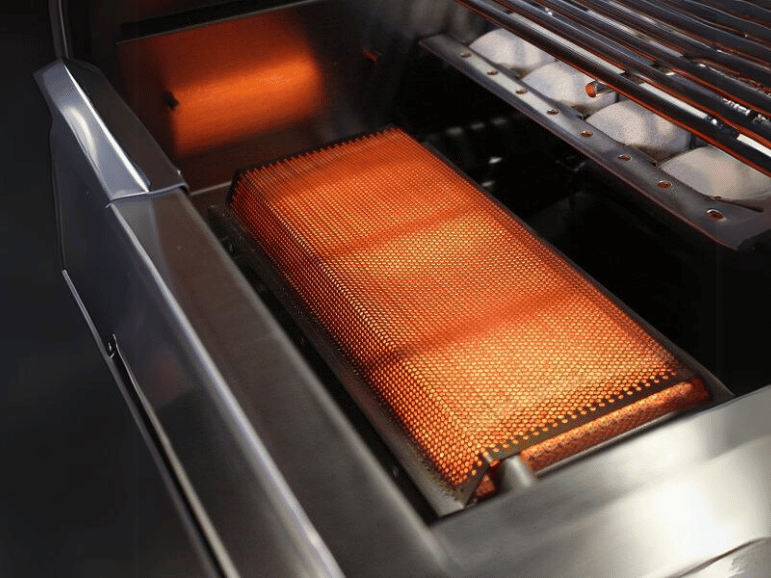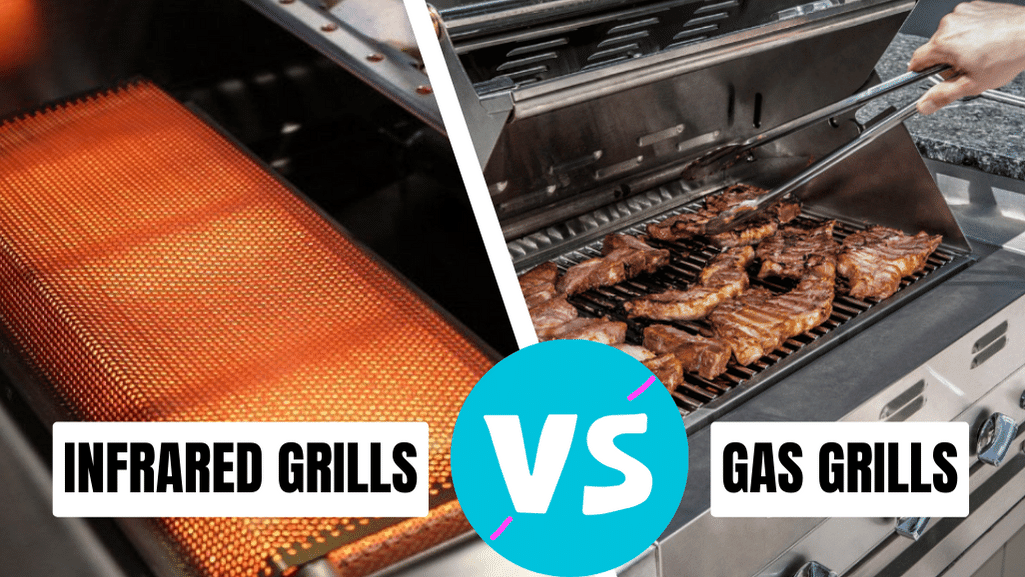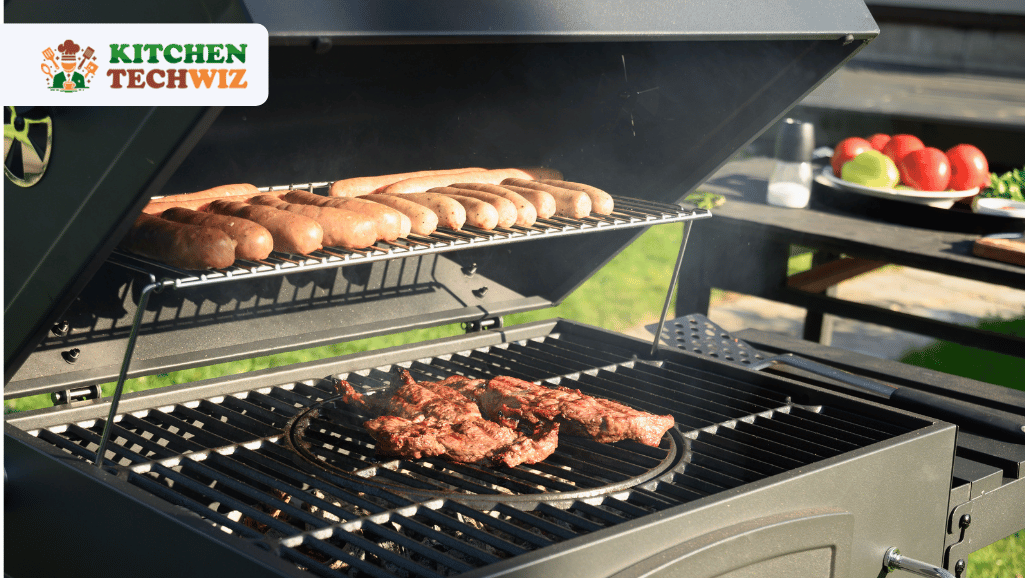If you’re debating between infrared and gas grills, it’s vital to know the pros and cons of each type before making a decision. Gas grills are most popular type on the market. However, infrared grills are quickly gaining popularity for their ability to cook food more evenly. Here’s a look at the key differences between these two grills to decide which is right for you.
First, infrared grills heat up more quickly than gas grills. If you hurry to get your food cooked, an infrared grill is a way to go. Infrared grills use infrared radiation for cooking food. On the other hand, gas grills use gas (usually propane or natural gas) to heat a metal surface, and this metal surface then cooks the food.
Another thing to consider is how evenly the heat is distributed on the grill. With an infrared grill, the heat is more evenly distributed, which means your food will cook more evenly. Gas grills tend to have hot spots so food can get overcooked in those areas.
So, which type of grill is better? It depends on what you’re looking for. If you want a grill that heats up quickly and evenly, then an infrared grill is a good option. However, a gas grill may be a better choice if you’re looking for a more affordable grill.
Table of Contents
Comparing Infrared Grills and Gas Grills
| Aspect | Infrared Grills | Gas Grills |
|---|---|---|
| Heat Distribution | Uses radiant heat technology for even distribution across the cooking surface. | Relies on convection heat, leading to potential hot spots and uneven cooking. |
| Temperature Control | Reaches higher temperatures faster, ideal for searing meats and achieving caramelization. Holds temperature consistently. | Offers decent temperature control, but may not match the rapid heating and precise regulation of infrared models. |
| Texture and Taste | Results in more consistent and flavorful cooking. | May lead to uneven cooking, impacting texture and taste. |
| Advantages | Even heat distribution, superior temperature control. | Decent temperature control, generally more affordable. |
| Drawbacks | Higher initial cost, may require more maintenance. | Potential for hot spots, slower heating time. |
When it comes to choosing between infrared grills and gas grills, one of the primary factors to consider is heat distribution. Infrared grills use a radiant heat technology that allows for even heat distribution across the cooking surface, resulting in more consistent and flavorful cooking. Gas grills, on the other hand, rely on convection heat, which can lead to hot spots and uneven cooking. This difference in heat distribution ultimately impacts the texture and taste of the food being cooked.
Another key consideration is temperature control. Infrared grills are known for their ability to reach higher temperatures faster than gas grills, making them ideal for searing meats and achieving that perfect caramelization. Additionally, infrared grills tend to hold their temperature more consistently, providing greater precision for different cooking techniques. While gas grills offer decent temperature control, they may not match the rapid heating and precise regulation offered by infrared models.
In conclusion, when comparing infrared grills and gas grills, it’s apparent that each type has its own set of advantages and drawbacks. While infrared grills excel in terms of even heat distribution and superior temperature control, there are other factors such as cost and maintenance that must be taken into account before making a decision on which type of grill is best suited for individual needs.
What is an Infrared Grill?

Infrared grills are a game-changer in the world of outdoor cooking, offering a whole new level of efficiency and flavor. Unlike traditional gas or charcoal grills that cook food through convection heat, infrared grills use radiant heat to directly sear the food at high temperatures. This innovative technology allows for even distribution of heat across the grill surface, resulting in perfectly cooked meats with delicious caramelization and juiciness.
One of the key advantages of an infrared grill is its ability to reach incredibly high temperatures in a matter of minutes, making it ideal for quick and efficient cooking. In addition, this rapid heating process locks in the natural juices of the food, preserving its moisture and tenderness. With an infrared grill, you can achieve restaurant-quality sear marks on your steaks and burgers, elevating your grilling experience to new heights. Whether you’re a seasoned grill master or just starting out, the precision and speed offered by an infrared grill make it a compelling choice for any outdoor cooking enthusiast.
Overall, an infrared grill introduces a new dimension to traditional grilling methods by enhancing flavor retention and reducing cooking time. The ability to quickly achieve high temperatures while maintaining juicy cuts of meat is unmatched by conventional gas grills. If you’re looking to take your outdoor cooking game to the next level with professional results every time, investing in an infrared grill might just be the upgrade you’ve been waiting for.
What is a Gas Grill?

Gas grills are a popular choice among outdoor cooking enthusiasts due to their convenience and ease of use. These grills utilize propane or natural gas as fuel, providing a consistent and controllable source of heat for cooking. The design typically includes burners that distribute heat evenly across the grilling surface, allowing for precise temperature control and efficient cooking.
One of the main advantages of gas grills is their quick startup time, eliminating the need to wait for charcoal to reach optimal cooking temperatures. Additionally, many gas grills feature additional components such as side burners, rotisserie kits, and smoker boxes, expanding their versatility beyond traditional grilling. With minimal cleanup required compared to charcoal grills, gas models are often favored for their user-friendly maintenance and efficient operation.
Overall, gas grills offer a reliable and convenient option for outdoor cooking, making them a popular choice for both experienced chefs and casual grillers alike. However, whether they surpass infrared grills in terms of performance remains a subject of debate among barbecue aficionados.
Performance Comparison
| Performance Aspect | Infrared Grills | Traditional Gas Grills |
|---|---|---|
| Temperature Generation | High and consistent temperatures; excels at searing meats, locking in juices, and creating caramelized crust without sacrificing moisture | Relies on convective heat flow, leading to potentially uneven heating and longer cooking times |
| Heat Distribution | Superior heat distribution across the cooking surface; more uniform results when grilling various food items simultaneously | May result in uneven heat distribution, leading to potential hot spots and cold spots |
| Speed of Cooking | Quicker cook times due to intense radiant heat; reduced flare-ups compared to gas grills | Cooking times may be longer due to convective heat flow; higher likelihood of flare-ups |
| Overall Performance Edge | Provides better temperature control, speed of cooking, and even heat distribution | Tends to have limitations in temperature control and may result in slower cooking times with less uniform heat distribution |
When it comes to performance, the infrared grills have gained a reputation for their ability to generate high and consistent temperatures, resulting in quick and even cooking. The infrared technology excels at searing meats, locking in juices, and creating that coveted caramelized crust without sacrificing moisture. In contrast, traditional gas grills rely on convective heat flow which can lead to uneven heating and longer cooking times.
Furthermore, infrared grills are known for their superior heat distribution across the cooking surface. This means more uniform results when grilling various food items simultaneously. Additionally, the intense radiant heat produced by infrared grills allows for a more efficient transfer of energy to the food, resulting in quicker cook times and reduced flare-ups compared to gas grills. Overall, when it comes to pure performance capabilities such as temperature control, speed of cooking, and even heat distribution – the infrared grill appears to have the edge over its traditional gas counterpart.
Heat Distribution and Efficiency
When it comes to heat distribution and efficiency, infrared grills offer a unique advantage over traditional gas grills. The infrared technology used in these grills allows for more even heat distribution across the cooking surface, ensuring that every part of the food receives consistent and thorough cooking. This not only results in better-tasting food but also reduces the likelihood of unevenly cooked or burnt portions.
Additionally, the efficiency of infrared grills is notable due to their ability to reach higher temperatures more quickly than gas grills. This means less preheating time and ultimately quicker cooking times, making them a fantastic option for those who want to get dinner on the table faster without sacrificing quality. With superior heat distribution and efficiency, it’s clear that infrared grills have a lot to offer for those seeking an enhanced grilling experience.
Maintenance and Longevity
When it comes to maintenance and longevity, infrared grills have emerged as a game-changer in the world of outdoor cooking. Unlike traditional gas grills, which often require frequent cleaning and replacement of components such as burners and flavor bars, infrared grills are designed for durability. The absence of an open flame reduces the risk of flare-ups that can damage grill parts, while the even heat distribution minimizes hot spots that can cause uneven wear and tear on the unit. This translates into lower maintenance costs and fewer replacement parts over time.
Moreover, the design of infrared grills promotes longevity by allowing for consistent cooking temperatures without relying on direct contact with flames or hot metal surfaces. This gentler cooking process not only enhances food flavor but also helps preserve the lifespan of both the grill itself and its cooking grates. With easier maintenance and prolonged durability, it’s evident that infrared grills offer a compelling advantage over traditional gas models in terms of long-term value for outdoor chefs seeking premium performance.
What is the Best Selling Infrared GillS?
Here are the list of the best selling Infrared Grill Models:
- Char-Broil® Performance Series™ TRU-Infrared Cooking…
- Tec Sterling Patio Fr 26-inch Freestanding Infrared Propane Gas…
- No products found.
- Char-Broil® Patio Bistro® TRU-Infrared Electric Grill, Blue -…
- Solaire SOL-EV17A Everywhere Portable Infrared Propane Gas Grill,…
1. Char-Broil Performance TRU-Infrared 450 3-Burner Cart Style Gas Grill:
This grill features a 450 square inch cooking surface and three stainless steel burners for efficient heat distribution. The TRU-Infrared technology ensures even cooking and eliminates flare-ups, while the cart style design offers portability and convenience.
2. TEC Patio FR 26-Inch Infrared Propane Gas Grill:
With its all-infrared design, this grill delivers exceptional heat and precise temperature control. The 604 square inch cooking surface provides ample space for grilling, and the stainless steel construction ensures durability. It also comes with an advanced temperature gauge for accurate cooking.
3. Blue Rhino Black and Stainless Steel 3-Burner Liquid Propane Gas Grill:
No products found.
This infrared grill features three stainless steel burners and a total cooking area of 450 square inches. It offers a reliable and consistent heat source, and the foldable side shelves provide extra workspace. Its sleek black and stainless steel design adds style to any outdoor kitchen.
4. TRU-Infrared Electric Grill, Blue – 20602107-01
Discover quality electric grilling with the Char-Broil Patio Bistro TRU-Infrared Electric Grill. Fast, even heat with no flare-ups and juicier food on 320 sq inches of cooking space. Features include an easy control knob, durable porcelain-coated grates, and a tool shelf. Ideal for small patios, it offers hassle-free, quality grilling.
5. Solaire SOL-EV17A Everywhere Portable Infrared Propane Gas Grill:
Perfect for outdoor cooking on the go, this portable grill packs a punch with its intense infrared heat. It features a 140 square inch grilling area, stainless steel construction, and a simple push-button ignition for easy start-ups. Its compact size and lightweight design make it ideal for camping, tailgating, or picnics.
What are the Disadvantages of Infrared Cooking?
Some disadvantages of infrared cooking include the following:

- Infrared grills tend to be more expensive than traditional grills.
- Infrared burners may produce hot spots, resulting in uneven cooking.
- Delicate foods can easily burn or overcook on infrared burners.
- Infrared grills may not provide the same flavors as traditional grills, as they don’t produce smoke.
- Infrared grills require regular cleaning to remove food particles that can block the burners.
- Infrared grills have limited temperature control options compared to other grills.
Conclusion
In conclusion, the choice between infrared grills and gas grills ultimately comes down to personal preference and specific needs. Infrared grills offer a unique cooking technology that allows for efficient heat distribution and faster cooking times, making them perfect for those who value convenience and speed. On the other hand, gas grills provide a traditional cooking experience and have a wider range of options in terms of size, features, and price points.
Frequently Asked Questions
Is infrared heating cheaper than gas?
Using infrared heating can be more cost-effective than using gas.
Is infrared better than gas?
Infrared grilling is generally considered better than traditional gas grilling because it provides more intense heat and cooks food faster. Infrared grills use an infrared element instead of gas flames as the heat source, resulting in more even and consistent temperatures across the cooking surface. This leads to juicier and more tender meats. Additionally, infrared grills often have additional features such as convection heating and moisture barriers, which further enhance the cooking process. Despite being more expensive than gas grills, infrared grills are energy-efficient and offer a wider variety of cooking options.
Is infrared grilling healthy?
Infrared grilling can be a healthier cooking option. It uses intense heat to quickly sear the food, which helps to retain more moisture and nutrients compared to traditional grills. Additionally, since infrared heat is focused and evenly distributed, it reduces the risk of flare-ups and burning, which can be harmful. Overall, infrared grilling can help you enjoy healthier and juicier meats.
Is an infrared grill worth it?
Yes, an infrared grill is worth it because it provides intense heat, cooks food faster, and produces juicier and tender meats compared to conventional grills.
Do restaurants use infrared grills?
Yes, some restaurants use infrared grills for their cooking needs.
Is infrared safe for humans?
Yes, infrared is safe for humans. Infrared heat is a form of electromagnetic radiation that is similar to the heat we feel from the sun. It is used in many everyday applications, such as heating food, warming homes, and even in medical treatments. However, it is always important to follow safety guidelines and not expose yourself to excessive levels of infrared heat.
What are the risks of infrared heat?
The main risk of infrared heat is the potential for burns or skin damage if the heat source is too close or of high intensity.
Why is infrared heating not popular?
Infrared heating is not very popular because it is not well-known and is often more expensive than other heating methods. Many people are also used to conventional heating methods and may not be familiar with the benefits of infrared heating.
Does infrared heat use a lot of electricity?
No, infrared heat does not use a lot of electricity.
Last update on 2024-11-24/Affiliate links / Images from Amazon Product Advertising API








![16 Best Tabletop Propane Gas Grills 2024: [Also Charcoal & Electric]](https://kitchentechwiz.com/wp-content/uploads/2021/04/Best-Tabletop-Propane-Grill-1.jpg)
Leave a Reply